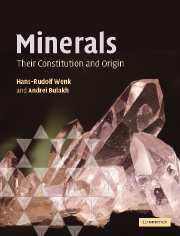Book contents
- Frontmatter
- Contents
- Preface
- Acknowledgments
- Figure credits
- Part I Structural features of minerals
- Part II Physical investigation of minerals
- 7 Experimental studies of crystal structures. X-ray diffraction
- 8 Physical properties
- 9 Optical properties
- 10 Identification of minerals with the petrographic microscope
- 11 Color
- 12 Additional analytical methods
- 13 Mechanical properties and deformation
- Part III Variety of minerals and mineral-forming processes
- Part IV A systematic look at mineral groups
- Part V Applied mineralogy
- Appendices
- Glossary
- References
- Index
- Plate section
- References
7 - Experimental studies of crystal structures. X-ray diffraction
from Part II - Physical investigation of minerals
- Frontmatter
- Contents
- Preface
- Acknowledgments
- Figure credits
- Part I Structural features of minerals
- Part II Physical investigation of minerals
- 7 Experimental studies of crystal structures. X-ray diffraction
- 8 Physical properties
- 9 Optical properties
- 10 Identification of minerals with the petrographic microscope
- 11 Color
- 12 Additional analytical methods
- 13 Mechanical properties and deformation
- Part III Variety of minerals and mineral-forming processes
- Part IV A systematic look at mineral groups
- Part V Applied mineralogy
- Appendices
- Glossary
- References
- Index
- Plate section
- References
Summary
Basic concepts
The notion that crystals have a lattice-based structure and that the basic building block is the unit cell was introduced in the eighteenth century. At that time the analysis of crystals was based on visual inspection, on detailed examination with a hand lens or at best a light microscope. However, visible light, with wavelengths between 400 and 700 nm, is far too coarse a probe to investigate crystal structures where information is on the scale of atoms and interatomic distances, i.e., 1–5 Å (1 Å = 0.1 nm). In this chapter we discuss experimental techniques that were developed in the early twentieth century to study crystal lattices, providing a tool for determining structural parameters and largely confirming the concepts about unit parallelepipeds, lattice structure, and symmetry suggested more than 100 years earlier. With the discovery of X-rays by C.W. Röntgen in 1895, the stage was set for analyzing crystals at an elementary level, and this research produced unprecedented information about the solid state. Then in 1912 the famous diffraction experiment of Max von Laue established that X-rays are waves and that the suspected internal lattice structure of crystals indeed existed (for a brief history, see Box 7.1).
Röntgen found that when electrons were accelerated in an electric field and collided with a metal anode, a very high-energy radiation was emitted.
- Type
- Chapter
- Information
- MineralsTheir Constitution and Origin, pp. 117 - 133Publisher: Cambridge University PressPrint publication year: 2004



